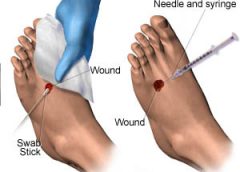When and how to culture a chronic wound
Chronic wound infections are a significant healthcare burden, contributing to increased morbidity and mortality, prolonged hospitalization, limb loss, and higher medical costs. What’s more, they pose a potential sepsis risk for patients. For wound care providers, the goal is to eliminate the infection before these consequences arise.
Most chronic wounds are colonized by polymicrobial aerobic-anaerobic microflora. However, practitioners continue to debate whether wound cultures are relevant. Typically, chronic wounds aren’t cultured unless the patient has signs and symptoms of infection, which vary depending on whether the wound is acute or chronic.
A case of missed care
By Lydia A. Meyers RN, MSN, CWCN Missed care, a relatively new concept in the medical community, refers to any part ofrequired patient care that is omitted of delayed. It’s not the same as a mistake or error, but like them, missed care can negatively affect patient outcomes. I want to share the case of a patient admitted into home…
Avoid surprises when connecting between care settings
By Jeri Lundgren, BSN, RN, PHN, CWS, CWCN As wound care clinicians, we know that an interdisciplinary, holistic approach to prevention and management of a wound is crucial to positive outcomes, no matter where the patient is being seen. Yet too often when a patient transfers from one care setting to another, the only wound information that’s communicated is the…
Clinical Notes: diabetic foot osteomyelitis, BIA, footwear
Antibiotics and conservative surgery yield similar outcomes in patients with diabetic foot osteomyelitis A study in Diabetes Care finds that antibiotics and surgery have similar outcomes related to rate of healing, time of healing, and short-term complications in patients who have neuropathic forefoot ulcers and osteomyelitis, but no ischemia or necrotizing soft-tissue infections. “Antibiotics versus conservative surgery for treating diabetic…
Clinician Resources
Greet the new year by tapping into some new resources. Free app for patients with Crohn’s Disease GI Buddy is a free tool from the Crohn’s & Colitis Foundation of America that patients can use to stay on top of managing their Crohn’s Disease or ulcerative colitis symptoms. Patients can record what they eat, track their treatment and well-being, and…
Fifty shades of wound care at home
By Beth Hoffmire Heideman, MSN, BSN, RN, WCC, DWC, OMS Fifty shades of wound care at home refers to treating the whole patient and the patient’s caregiving supporters—not just the wound. Only by understanding the nuances, or shades, of a patient and his or her environment can clinicians best achieve desired outcomes. Wound healing in home care depends on teamwork.…
Have you made your New Year’s resolutions?
Aresolution is a serious decision or determination to do, or not to do, something. Traditionally, most New Year’s resolutions focus on self-improvement: losing weight, giving up a bad habit, exercising more, being a better person. Because most of us spend about half of our waking lives at work, perhaps our work lives should be the subject of some of our resolutions. Here…
How to apply a spiral wrap
By Nancy Morgan, RN, BSN, MBA, WOC, WCC, DWC, OMS Each issue, Apple Bites brings you a tool you can apply in your daily practice. Description The spiral wrap is a technique used for applying compression bandaging. Procedure Here’s how to apply a spiral wrap to the lower leg. Please note that commercial compression wraps come with specific instructions for…

Managing venous stasis ulcers
By Kulbir Dhillon, MSN, FNP, APNP, WCC Venous disease, which encompasses all conditions caused by or related to diseased or abnormal veins, affects about 15% of adults. When mild, it rarely poses a problem, but as it worsens, it can become crippling and chronic. Chronic venous disease often is overlooked by primary and cardiovascular care providers, who underestimate its magnitude…
Mastering the art of meetings
By Toni Ann Loftus, MBA, RN, MHA Meetings are a powerful communication tool. They bring together people who can look at an issue from their own unique perspective and contribute to a solution acceptable to many disciplines. Generally, meetings are held to: • discuss common issues • brainstorm ideas for solving specific concerns • make collaborative decisions about a shared…
Quality-improvement initiative: Classifying and documenting surgical wounds
By Jennifer Zinn, MSN, RN, CNS-BC, CNOR, and Vangela Swofford, BSN, RN, ASQ-CSSBB For surgical patients, operative wound classification is crucial in predicting postoperative surgical site infections (SSIs) and associated risks. Information about a patient’s wound typically is collected by circulating registered nurses (RNs) and documented at the end of every surgical procedure.

When and how to culture a chronic wound
By Marcia Spear, DNP, ACNP-BC, CWS, CPSN Chronic wound infections are a significant healthcare burden, contributing to increased morbidity and mortality, prolonged hospitalization, limb loss, and higher medical costs. What’s more, they pose a potential sepsis risk for patients. For wound care providers, the goal is to eliminate the infection before these consequences arise. Most chronic wounds are colonized by…
Click here to access the digital edition
